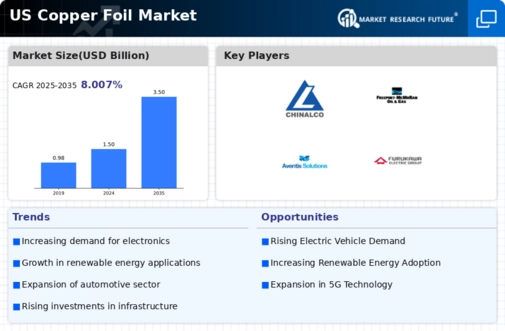The copper foil market exhibits a dynamic competitive landscape characterized by a blend of innovation, strategic partnerships, and regional expansion. Key players such as Southern Copper Corporation (US), AFC Cable Systems (US), and Furukawa Electric Co Ltd (Japan) are actively shaping the market through their distinct operational focuses. Southern Copper Corporation (US) emphasizes sustainable mining practices and has invested in advanced technologies to enhance production efficiency. Meanwhile, AFC Cable Systems (US) is concentrating on expanding its product offerings to cater to the growing demand for electric vehicles (EVs) and renewable energy applications. Furukawa Electric Co Ltd (Japan) appears to be leveraging its extensive R&D capabilities to innovate in high-performance copper foil solutions, thereby enhancing its competitive positioning in the market.
The business tactics employed by these companies reflect a concerted effort to optimize supply chains and localize manufacturing. The market structure is moderately fragmented, with several players vying for market share, yet the influence of major companies remains pronounced. This competitive environment fosters innovation and drives companies to adopt more efficient production methods, ultimately benefiting end-users through improved product offerings.
In November 2025, Southern Copper Corporation (US) announced a strategic partnership with a leading EV manufacturer to supply high-quality copper foil for battery production. This collaboration is poised to enhance Southern Copper's market presence in the burgeoning EV sector, aligning with the industry's shift towards sustainable energy solutions. The partnership underscores the importance of strategic alliances in accessing new markets and driving growth.
In October 2025, AFC Cable Systems (US) launched a new line of copper foil products specifically designed for high-frequency applications. This product line aims to meet the increasing demand for advanced telecommunications infrastructure. The introduction of these products not only diversifies AFC's portfolio but also positions the company as a key player in the telecommunications sector, which is experiencing rapid growth due to the expansion of 5G networks.
In September 2025, Furukawa Electric Co Ltd (Japan) unveiled a new manufacturing facility in the US, aimed at increasing production capacity for its copper foil products. This facility is expected to enhance Furukawa's ability to meet the rising demand from North American customers, particularly in the automotive and electronics sectors. The establishment of this facility indicates Furukawa's commitment to regional expansion and its strategy to strengthen its supply chain resilience.
As of December 2025, the copper foil market is increasingly influenced by trends such as digitalization, sustainability, and the integration of AI technologies. Companies are recognizing the need for strategic alliances to navigate the complexities of the market and enhance their competitive edge. The shift from price-based competition to a focus on innovation and technology is evident, as companies strive to differentiate themselves through superior product offerings and reliable supply chains. Looking ahead, the competitive landscape is likely to evolve further, with an emphasis on sustainable practices and technological advancements driving future growth.















Leave a Comment